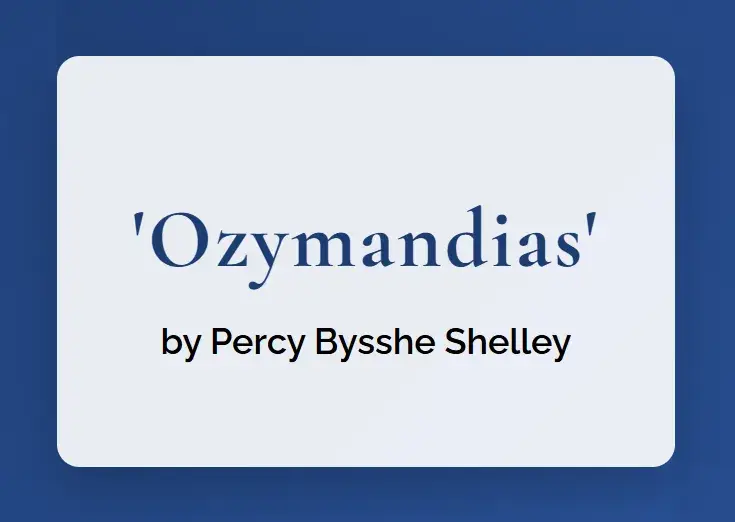Background
“Ozymandias” is a sonnet written by the Romantic poet Percy Bysshe Shelley. It was first published in the 11 January 1818 issue of The Examiner in London. The poem is named after the Greek name for Rameses II, a powerful Egyptian pharaoh. Shelley wrote this poem in friendly competition with his friend Horace Smith, who also composed a sonnet on the same topic.
Structure
- Form: Sonnet (Petrarchan with a variation in the sestet)
- Lines: 14 lines
- Rhyme scheme: ABABACDCEDEFEF
- Meter: Iambic pentameter
Content and Analysis
The poem begins with the narrator recounting a meeting with a traveler:
I met a traveller from an antique land,
Who said—"Two vast and trunkless legs of stone
Stand in the desert. . . . Near them, on the sand,
Half sunk a shattered visage lies, whose frown,
This opening employs a frame narrative, creating distance between the reader and the subject. The vivid imagery of the “trunkless legs” and “shattered visage” immediately evokes a sense of decay and ruin. The enjambment between the first and second lines creates a sense of anticipation, mirroring the traveler’s discovery.
The description of the statue continues:
And wrinkled lip, and sneer of cold command,
Tell that its sculptor well those passions read
Which yet survive, stamped on these lifeless things,
The hand that mocked them, and the heart that fed;
Here, Shelley uses personification to bring the statue to life. The “sneer of cold command” is particularly effective in conveying the character of Ozymandias. The phrase “the hand that mocked them” is a clever play on words – “mock” here means both to imitate (in sculpture) and to deride, suggesting the sculptor’s possible subversion of the pharaoh’s intent.
The inscription on the pedestal is then revealed:
And on the pedestal, these words appear:
My name is Ozymandias, King of Kings;
Look on my Works, ye Mighty, and despair!
This direct quote creates a dramatic irony. The grandiose claim of Ozymandias is starkly contrasted with the ruined state of his statue, emphasizing the transient nature of power and glory.
The poem concludes with a description of the barren landscape:
Nothing beside remains. Round the decay
Of that colossal Wreck, boundless and bare
The lone and level sands stretch far away."
The alliteration in “lone and level” emphasizes the emptiness of the scene. The capitalization of “Wreck” personifies the ruins, giving them a monumental quality that ironically echoes Ozymandias’s own inflated sense of importance.
Themes
- The Transience of Power: The central theme of the poem is the impermanence of human power and glory in the face of time.
- Hubris: Ozymandias’s boastful inscription demonstrates the folly of excessive pride.
- Art vs. Power: The endurance of the sculptor’s skill outlasts the power of the king he immortalized.
- Nature’s Supremacy: The vast, empty desert serves as a reminder of nature’s indifference to human ambitions.
Literary Devices
- Irony: The contrast between Ozymandias’s boast and the reality of his ruined statue.
- Imagery: Vivid descriptions that bring the scene to life.
- Symbolism: The shattered statue symbolizes the impermanence of power.
- Alliteration: “boundless and bare” emphasizes the emptiness of the desert.
- Enjambment: Used throughout to create a sense of flow and anticipation.
Historical and Personal Context
Shelley wrote “Ozymandias” during a period of revolutionary change in Europe. The poem can be seen as a commentary on the ephemeral nature of political power, perhaps reflecting on the recent fall of Napoleon.
The poem also reflects the Romantic fascination with ancient civilizations and ruins. The rediscovery of ancient Egyptian culture was a significant influence on European art and literature of the time.
Legacy
“Ozymandias” has become one of Shelley’s most famous poems and a classic of Romantic literature. Its exploration of themes of power, time, and human vanity continues to resonate with readers.
The poem has had a significant cultural impact, with its central image and message referenced in various works of literature, film, and television. The phrase “Look on my works, ye Mighty, and despair!” has become particularly well-known, often quoted or alluded to in discussions of hubris and the transience of power.
In literature and cultural studies, “Ozymandias” is often analyzed as an example of the sublime in Romantic poetry, where the vast, indifferent natural world dwarfs human concerns. It’s also studied for its skillful use of the sonnet form to create a narrative arc within a compact space.
The poem’s enduring popularity and relevance demonstrate how a brief, vivid meditation on a single image can encapsulate profound truths about the human condition and the nature of existence.


